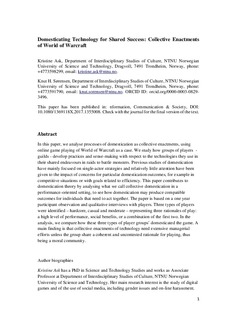| dc.contributor.author | Ask, Kristine | |
| dc.contributor.author | Sørensen, Knut Holtan | |
| dc.date.accessioned | 2017-08-17T06:36:56Z | |
| dc.date.available | 2017-08-17T06:36:56Z | |
| dc.date.created | 2017-08-11T12:21:16Z | |
| dc.date.issued | 2017 | |
| dc.identifier.issn | 1369-118X | |
| dc.identifier.uri | http://hdl.handle.net/11250/2450955 | |
| dc.description.abstract | In this paper, we analyse processes of domestication as collective enactments, using online game playing of World of Warcraft as a case. We study how groups of players – guilds – develop practices and sense-making with respect to the technologies they use in their shared endeavours in raids to battle monsters. Previous studies of domestication have mainly focused on single-actor strategies and relatively little attention have been given to the impact of concerns for particular domestication outcomes, for example in competitive situations or with goals related to efficiency. This paper contributes to domestication theory by analysing what we call collective domestication in a performance-oriented setting, to see how domestication may produce compatible outcomes for individuals that need to act together. The paper is based on a one-year participant observation and qualitative interviews with players. Three types of players were identified – hardcore, casual and moderate – representing three rationales of play: a high level of performance, social benefits, or a combination of the first two. In the analysis, we compare how these three types of player groups’ domesticated the game. A main finding is that collective enactments of technology need extensive managerial efforts unless the group share a coherent and uncontested rationale for playing, thus being a moral community. | nb_NO |
| dc.language.iso | eng | nb_NO |
| dc.publisher | Taylor & Francis | nb_NO |
| dc.relation.uri | http://www.tandfonline.com/doi/abs/10.1080/1369118X.2017.1355008 | |
| dc.title | Domesticating technology for shared success: collective enactments of World of Warcraft | nb_NO |
| dc.type | Journal article | nb_NO |
| dc.type | Peer reviewed | nb_NO |
| dc.description.version | acceptedVersion | nb_NO |
| dc.source.journal | Information, Communication and Society | nb_NO |
| dc.identifier.doi | 10.1080/1369118X.2017.1355008 | |
| dc.identifier.cristin | 1485757 | |
| dc.description.localcode | This is an Accepted Manuscript of an article published by Taylor & Francis in Information, Communication and Society on 26 July 2017 , available online: http://www.tandfonline.com/doi/full/10.1080/1369118X.2017.1355008 . Locked until 26 January 2019 due to copyright restrictions. | nb_NO |
| cristin.unitcode | 194,62,40,0 | |
| cristin.unitname | Institutt for tverrfaglige kulturstudier | |
| cristin.ispublished | true | |
| cristin.fulltext | postprint | |
| cristin.qualitycode | 1 | |
